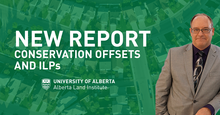Measuring Conservation Offsets: Why it Matters

It is becoming increasingly common for land and resource developers to offer, or be required to provide, compensation for the disturbance which they cause to natural ecosystems. One form of that compensation is payment to an agency that will use the funds to provide later benefits to the ecosystem. These are often referred to as “in-lieu” payments of fees because the payment is made in lieu of directly undertaking compensatory work to enhance the environment. For example, for several years a developer in Alberta who disturbs a wetland has been required to make a payment to a wetland restoration agent (usually Ducks Unlimited Canada) who is expected to use the funds to provide replacement or enhanced wetlands.
While such in-lieu payment (ILP) arrangements are becoming more common, many people are also skeptical as to whether they actually produce the expected benefits. It is that gap between ILP program aspirations and perceptions of performance that motivated Adam Driedzic and me to undertake a study of the operation of nine ILP programs in British Columbia, Alberta, New Brunswick and the United States. Our goal was to draw out useful experiences that could inform the design of new systems, including those currently under development provincially in Alberta and British Columbia.
In each case study, we looked at the legal authority for any requirement of a payment, how the payment amount is set, how funds are handled and by whom, how funds are expended, and what arrangements are made for monitoring and oversight of the program.
We found that most ILP programs for disturbance of land or water bodies have often started in a fairly informal manner at the initiative of individual development proponents or regulators. Over time, however, there has been a trend to greater structure and formality. This is in contrast to the world of carbon offsetting, where payment and other compensation options have often been carefully structured in law and regulation from the beginning.
We also found a deficit of transparency in the programs that we studied, a situation which has fed skepticism, but which probably can be easily addressed.
If properly designed to produce environmental benefits of the right type and scope, ILP programs can be useful tool to sustainably manage our land and resource base. We hope that our study will further that goal.
The results of the study can be found here.
Dave Poulton is the Director of the Alberta Land Institute